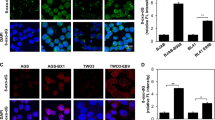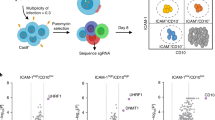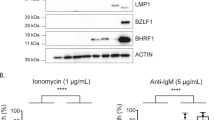Abstract
It is generally accepted that Epstein–Barr virus (EBV) latent genes EBNA-2, EBNA-3A, -3C, EBNA-LP and LMP1 are essential for growth transformation and immortalization of B lymphocytes. Among these genes, LMP1 plays a key role in the survival and dissemination of the infected B cells by inducing anti-apoptotic genes and surface expression of several activation antigens and adhesion molecules. We have previously shown that antisense oligodeoxynucleotides directed to LMP1 mRNA, effectively suppress LMP1 gene expression and substantially reduce B95.8 cell proliferation. In this study, we have used antisense LMP1 oligomers to investigate whether LMP1 suppression might influence the expression of latent EBV genes with oncogenic potential, anti-apoptotic genes, or affect the phenotype of EBV-infected B95.8 cells. Our data show that LMP1 suppression does not affect the transcription of EBNA-2, EBNA-3A, -3B and -3C genes, or that of bcl-2 and mcl-1 anti-apoptotic genes. In contrast, consistent modifications in the expression of CD39, CD54, CD23, CD11 and CD10 molecules were observed in B95.8 cells after treatment with antisense LMP1. Our findings support the possibility for using LMP1 antisense oligomers as therapeutics in EBV-associated tumors.
This is a preview of subscription content, access via your institution
Access options
Subscribe to this journal
Receive 50 print issues and online access
$259.00 per year
only $5.18 per issue
Buy this article
- Purchase on Springer Link
- Instant access to full article PDF
Prices may be subject to local taxes which are calculated during checkout




Similar content being viewed by others
References
Baichwal VR, Sugden B . 1988 Oncogene 2: 461–467
Cohen JL, Wang F, Mannick J, Kieff E . 1989 Proc. Natl. Acad. Sci. USA 86: 9558–9562
D'Souza B, Rowe M, Walls D . 2000 J. Virol. 74: 6652–6658
Fahraeus R, Rymo L, Rhim JS, Klein G . 1990 Nature 345: 447–449
Farrell P . 1995 Trends Microbiol. 3: 105–109
Hammerschmidt W, Sugden B . 1989 Nature 340: 393–397
Henderson S, Rowe M, Gregory C, Croom-Carter D, Wang F, Longnecker R, Kieff E, Rickinson A . 1991 Cell 65: 1107–1115
Hu LF, Chen F, Zheng X, Ernberg I, Cao SL, Christensson B, Klein G, Winberg G . 1993 Oncogene 8: 1575–1583
Kaye K, Izumi KM, Kieff E . 1993 Proc. Natl. Acad. Sci. USA 90: 9150–9154
Kempkes B, Spitkovsky D, Jansen-Durr P, Ellwart JW, Kremmer E, Delecluse HJ, Rottenberger C, Bornkamm GW, Hammerschmidt W . 1995 EMBO J. 14: 88–96
Kenney JL, Guinness ME, Curiel T, Lacy J . 1998 Blood 92: 1721–1727
Kintner CR, Sudgen B . 1981 Nature 294: 458–460
Kulwichit W, Edwards RH, Davenport EM, Baskar J, Godfrey V, Raab-Traub N . 1998 Proc. Natl. Acad. Sci. USA 95: 11963–11968
Martin JM, Veis D, Korsmeyer SJ, Sugden B . 1993 J. Virol. 67: 5269–5278
Mattia E, Chichiarelli S, Hickish T, Gaeta A, Mancini C, Cunningham D, Van Renswoude J . 1997 Oncogene 15: 489–493
Miller G . 1990 Virology Fields BN, Knipe DM, Chanock RM (eds) pp 1921–1958 New York: Raven
Nicholson LJ, Hopwood P, Johannessen I, Salisbury JR, Codd J, Thorley-Lawson D, Crawford DH . 1997 Oncogene 15: 275–283
Noguchi T, Ikeda K, Iamamoto K, Yoshida I, Ashiba A, Tsuchiyama J, Shinagawa K, Yoshino T, Takata M, Harada M . 2001 Br. J. Haematol. 114: 84–92
Patarroyo M, Beatty PG, Nillson K, Gahmberg CG . 1986 Int. J. Cancer 38: 539–547
Rowe M, Peng-Pilon M, Huen DS, Hardy R, Croom-Carter D, Lundgren E, Rickinson AB . 1994 J. Virol. 68: 5602–5612
Thorley-Lawson DA, Nadler LM, Bhan AK, Schooley RT . 1985 J. Immunol. 134: 3007–3012
Tomkinson B, Robertson E, Kieff E . 1993 J. Virol. 67: 2014–2025
Wang C, Liebowitz F, Gregory CD, Rickinson A, Larson R, Springer T, Kieff E . 1988 J. Virol. 62: 4173–4184
Wang D, Liebowitz D, Kieff E . 1985 Cell 43: 831–840
Wang F, Gregory CD, Sample C, Rowe M, Liebowitz D, Murray R, Rickinson A, Kieff E . 1990 J. Virol. 64: 2309–2318
Wang S, Rowe M, Lundgren E . 1996 Cancer Res. 56: 4610–4613
Acknowledgements
This work has been partially supported by a contribution of the ‘Istituto Pasteur, Fondazione Cenci Bolognetti', University of Rome, ‘La Sapienza’.
Author information
Authors and Affiliations
Corresponding author
Additional information
This paper is dedicated to the memory of our dear friends and colleagues, Giuseppe Carruba and Franco Tato' prematurely deceased.
Rights and permissions
About this article
Cite this article
Masciarelli, S., Mattioli, B., Galletti, R. et al. Antisense to Epstein Barr Virus-encoded LMP1 does not affect the transcription of viral and cellular proliferation-related genes, but induces phenotypic effects on EBV-transformed B lymphocytes. Oncogene 21, 4166–4170 (2002). https://doi.org/10.1038/sj.onc.1205515
Received:
Revised:
Accepted:
Published:
Issue Date:
DOI: https://doi.org/10.1038/sj.onc.1205515
Keywords
This article is cited by
-
Inhibition of p38 MAP kinase pathway induces apoptosis and prevents Epstein Barr virus reactivation in Raji cells exposed to lytic cycle inducing compounds
Molecular Cancer (2009)
-
Inhibition of Poly(ADP-ribose)polymerase impairs Epstein Barr Virus lytic cycle progression
Infectious Agents and Cancer (2007)



